Overcoming the Collaboration Barriers among Stakeholders in Urban Renewal Based on a Two-Mode Social Network Analysis
Abstract
1. Introduction
2. Literature Review
2.1. Stakeholders in Urban Renewal
2.2. Two-Mode SNA
3. Methods
3.1. Step 1: Identifying Network Nodes
3.2. Step 2: Evaluating Network Links
3.3. Step 3: Establishing a Two-Mode SNA Model
3.4. Step 4: Social Network Analysis
3.5. Step 5: Proposing and Validating Strategies
4. Results
4.1. Identification of Stakeholders and Collaboration Barriers
| Stakeholder | Description | Key References |
|---|---|---|
| Government (S1) | Development and Reform Commission | [10,42] |
| Urban Planning Bureau | ||
| Land, Resources, and Housing Bureau | ||
| Urban and Rural Development Commission | ||
| Land and Resources Bureau | ||
| Housing Administration Bureau | ||
| Local and other administrative organizations (S2) | Street Office | [43,44,45] |
| Community Committee | ||
| Consulting parties (S3) | Experts and Scholars | [10,46] |
| Real Estate Evaluation Agencies | ||
| Consulting Companies Involved in Urban Renewal And Urban Planning | ||
| Third-Party Companies Engaged in Smart City/Smart Community/Smart Interconnection | ||
| Big Data Technology Service Companies | ||
| Developers (S4) | Real Estate Development Company | [5,6] |
| Financial institutions (S5) | Bank | [10,47] |
| Owners (S6) | Affected Residents | [6,48] |
| (General) Public (S7) | [41,49] | |
| Non-governmental organizations (NGOs) (S8) | Trade Associations | [46,50,51] |
| Associations of Entrepreneurs | ||
| Associations of Self-employed Workers | ||
| Media (S9) | TV | [50,52] |
| Radio | ||
| Internet Media | ||
| Designers (S10) | Urban Design Practitioners | [44,51,52] |
| Architects | ||
| Planners | ||
| Gardeners | ||
| Contractors (S11) | The Construction Companies | [44,53] |
| Property party (S12) | Property Management Companies | From expert interviews |
| Operating agencies (S13) | Relevant Business Operators | From expert interviews |
| Collaboration Barrier | Description | Key References |
|---|---|---|
| Inadequate laws and regulations (B1) | There is no law on the theme of urban renewal in China, and only some cities have promulgated local regulations. | [10,54] |
| Frequent policy adjustments (B2) | Repeated policy changes affect the implementation of urban renewal projects. | [55] |
| Imperfect policy system (B3) | Many cities have yet to form a policy document system including special policies, technical standards and operational guidelines. | [56] |
| Vague boundary of property rights (B4) | The ownership of property is complicated and the ownership relationship is fuzzy, which easily leads to interest disputes. | [6,45] |
| Imperfect decision-making system (B5) | Strict separation of decision-making stage, lack of project planning guidance, lack of cross-departmental cooperation mechanism | [54] |
| Imperfect accountability mechanism (B6) | The imperfect accountability system affects the public’s supervision and restriction of rights. | [57] |
| Unequal and opaque information (B7) | Information is asymmetric among stakeholders, and public participation cannot rely on effective and transparent information communication. | [25,58] |
| Complex coordination procedure (B8) | The process is complicated and lacks cross-field cooperation mechanism, which leads to the inability of effective coordination among departments. | [54] |
| Lack of expert advice and expertise (B9) | The participation channels of experts and scholars are not smooth, and cognition and judgment do not play their due roles in key decisions. | [57,59] |
| Imperfect (operational) management system (B10) | Most of the projects lack of industry authority, property management and other management organizations, resulting in the follow-up management work being difficult to continue. | [60] |
| Inadequate supervision (B11) | Lack of supervision subject and the imperfect supervision system, easy to free-ride, the performance of duties is not in place and so on. | [25,56] |
| Unbalanced distribution of benefits (B12) | It is difficult for stakeholders to reach an agreement on urban renewal compensation and social benefit distribution. | [45,61] |
| Single financing model (B13) | Single investment entity, limited funds, use market mechanism to introduce social capital insufficiency | [57] |
| Inefficient investment of capital (B14) | The short-term economic benefits of some renewal projects are low, and the income and expenditure of funds are difficult to balance. | [8] |
| Different awareness of stakeholders (B15) | There is a strong distrust of one group toward the other in moving cities on a more sustainable path. | [10,42] |
| Lack of participation willingness (B16) | The public tends to rely on the government to make decisions in China. They usually pay more attention to their own interests than to the public interest. | [48,58] |
| Lack of participation policies (B17) | There are still no policies for the public on how to express their demands and realize the right to know, participation and supervision of management. | [42,58] |
| Problems of social equity (B18) | On the aspects of law and policy, it neglects the protection of social fairness and the interests of vulnerable groups and affects the system fairness and democracy. | [25,56,62] |
4.2. Stakeholder–Collaboration Barrier Adjacency Matrix
4.3. Visualizing Stakeholder–Collaboration Barrier Network
4.4. Centrality and Core–Periphery Structure
5. Discussion
5.1. The Power of Stakeholders in Urban Renewal
5.2. Core Stakeholders and Key Collaboration Barriers in Urban Renewal
5.3. Stakeholders’ Collaboration Path in Urban Renewal
6. Strategies Proposal and Verification
6.1. Strategies to Promote Collaboration
6.1.1. Providing Policy Guarantee
6.1.2. Improving the Management System
6.1.3. Establishing Information Exchange Platforms
6.1.4. Providing Financial Support
6.1.5. Public Participation
6.2. Verifying the Validity of Strategies
7. Conclusions
Author Contributions
Funding
Data Availability Statement
Conflicts of Interest
Appendix A. The Sample of Expert Questionnaire
- (1)
- Nature of your organization:☐Government ☐Local and other administrative organization ☐Consulting party ☐Developer ☐Financial institution ☐NGOs ☐Media ☐Designer ☐Contractor ☐Property management company ☐Operating agency ☐Others
- (2)
- Your education background:☐Doctor ☐Master ☐Undergraduate ☐Junior college ☐High school ☐Others
- (3)
- Your work experience:☐Less than 1 year ☐1–5 years ☐6–10 years ☐11–15 years ☐16–20 years ☐Over 20 years
- (4)
- Have you ever participated in projects/studies related to urban renewal:☐No ☐1–3 ☐More than 3
| Stakeholders | Collaboration Barriers | |||||||||||||||||
|---|---|---|---|---|---|---|---|---|---|---|---|---|---|---|---|---|---|---|
| Inadequate Laws and Regulations | Frequent Policy Adjustments | Imperfect Policy System | Vague Boundary of Property Rights | Imperfect Decision-Making System | Imperfect Accountability Mechanism | Unequal and Opaque Information | Complex Coordination Procedure | Lack of Expert Advice and Expertise | Imperfect (Operational) Management System | Inadequate Supervision | Unbalanced Distribution of Benefits | Single Financing Model | Inefficient Investment of Capital | Different Awareness of Stakeholders | Lack of Participation Willingness | Lack of Participation Policies | Problems of Social Equity | |
| Government | ||||||||||||||||||
| Local and other administrative organizations | ||||||||||||||||||
| Consulting parties | ||||||||||||||||||
| Developers | ||||||||||||||||||
| Financial institutions | ||||||||||||||||||
| Owners | ||||||||||||||||||
| (General) Public | ||||||||||||||||||
| NGOs | ||||||||||||||||||
| Media | ||||||||||||||||||
| Designers | ||||||||||||||||||
| Contractors | ||||||||||||||||||
| Property party | ||||||||||||||||||
| Operating agencies | ||||||||||||||||||
| Rating of Relationship between Your Institution and Other Institutions | Specific Strategies | ||||||||||
|---|---|---|---|---|---|---|---|---|---|---|---|
| Before | After | ||||||||||
| 1 | 2 | 3 | 4 | 5 | 1 | 2 | 3 | 4 | 5 | ||
| Government |
| ||||||||||
| Local and other administrative organizations | |||||||||||
| Consulting parties | |||||||||||
| Developers | |||||||||||
| Financial institutions | |||||||||||
| Owners | |||||||||||
| (General) Public | |||||||||||
| NGOs | |||||||||||
| Media | |||||||||||
| Designers | |||||||||||
| Contractors | |||||||||||
| Property party | |||||||||||
| Operating agencies | |||||||||||
References
- Li, L.; Sun, W.; Hu, W.; Sun, Y. Impact of natural and social environmental factors on building energy consumption: Based on bibliometrics. J. Build. Eng. 2021, 37, 102136. [Google Scholar] [CrossRef]
- Lin, S.H.; Huang, X.; Fu, G.; Chen, J.T.; Zhao, X.; Li, J.H.; Tzeng, G.H. Evaluating the sustainability of urban renewal projects based on a model of hybrid multiple-attribute decision-making. Land Use Policy 2021, 108, 105570. [Google Scholar] [CrossRef]
- Chen, Y.; Han, Q.; Liu, G.; Wu, Y.; Li, K.; Hong, J. Determining critical success factors of urban renewal projects: Multiple integrated approach. J. Urban Plann. Dev. 2022, 148, 04021058. [Google Scholar] [CrossRef]
- Wang, Y.; Yao, Y.; Zhang, Y.; Xiang, L. A Framework of Stakeholder Relationship Analysis for an Urban Regeneration Project Based on Social Network Analysis: A Dynamic Perspective. J. Urban Plann. Dev. 2022, 148, 04022035. [Google Scholar] [CrossRef]
- Wang, Y.; Li, J.; Zhang, G.; Li, Y.; Asare, M.H. Fuzzy evaluation of comprehensive benefit in urban renewal based on the perspective of core stakeholders. Habitat Int. 2017, 66, 163–170. [Google Scholar] [CrossRef]
- Liu, G.; Wei, L.; Gu, J.; Zhou, T.; Liu, Y. Benefit distribution in urban renewal from the perspectives of efficiency and fairness: A game theoretical model and the government’s role in China. Cities 2020, 96, 102422. [Google Scholar] [CrossRef]
- Chu, X.; Shi, Z.; Yang, L.; Guo, S. Evolutionary game analysis on improving collaboration in sustainable urban regeneration: A multiple-stakeholder perspective. J. Urban Plann. Dev. 2020, 146, 04020046. [Google Scholar] [CrossRef]
- Shen, T.; Yao, X.; Wen, F. The Urban Regeneration Engine Model: An analytical framework and case study of the renewal of old communities. Land Use Policy 2021, 108, 105571. [Google Scholar] [CrossRef]
- Zhang, W.; Zhang, X.; Wu, G. The network governance of urban renewal: A comparative analysis of two cities in China. Land Use Policy 2021, 106, 105448. [Google Scholar] [CrossRef]
- Zhuang, T.; Qian, Q.K.; Visscher, H.J.; Elsinga, M.G.; Wu, W. The role of stakeholders and their participation network in decision-making of urban renewal in China: The case of Chongqing. Cities 2019, 92, 47–58. [Google Scholar] [CrossRef]
- Lin, X.; Ho, C.M.; Shen, G.Q. Who should take the responsibility? Stakeholders’ power over social responsibility issues in construction projects. J. Clean. Prod. 2017, 154, 318–329. [Google Scholar] [CrossRef]
- Yu, J.; Leung, M.Y. Structural stakeholder model in public engagement for construction development projects. J. Constr. Eng. Manag. 2018, 144, 04018046. [Google Scholar] [CrossRef]
- Freeman, R.E. Strategic Management: A Stakeholder Approach; Cambridge University Press: Cambridge, UK, 2010. [Google Scholar]
- Li, T.H.; Ng, S.T.; Skitmore, M. Conflict or consensus: An investigation of stakeholder concerns during the participation process of major infrastructure and construction projects in Hong Kong. Habitat Int. 2012, 36, 333–342. [Google Scholar] [CrossRef]
- Mayer, I.S.; van Bueren, E.M.; Bots, P.W.; van der Voort, H.; Seijdel, R. Collaborative decisionmaking for sustainable urban renewal projects: A simulation–gaming approach. Environ. Plann. B 2005, 32, 403–423. [Google Scholar] [CrossRef]
- Grimble, R. Stakeholder Methodologies in Natural Resource Management; Natural Resources Institute: Greenwich, UK, 1998. [Google Scholar]
- Schmeer, K. Guidelines for Conducting a Stakeholder Analysis; PHR, Abt Associates: Bethesda, MA, USA, 1999. [Google Scholar]
- Leung, M.Y.; Yu, J.; Liang, Q. Improving public engagement in construction development projects from a stakeholder’s perspective. J. Constr. Eng. Manag. 2013, 139, 04013019. [Google Scholar] [CrossRef]
- Cheng, A.S.; Mattor, K.M. Why won’t they come? Stakeholder perspectives on collaborative national forest planning by participation level. Environ. Manage. 2006, 38, 545–561. [Google Scholar] [CrossRef] [PubMed]
- Xue, H.; Zhang, S.; Su, Y.; Wu, Z.; Yang, R.J. Effect of stakeholder collaborative management on off-site construction cost performance. J. Clean. Prod. 2018, 184, 490–502. [Google Scholar] [CrossRef]
- Zhou, Z. Towards collaborative approach? Investigating the regeneration of urban village in Guangzhou, China. Habitat Int. 2014, 44, 297–305. [Google Scholar] [CrossRef]
- Soma, K.; Dijkshoorn-Dekker, M.W.C.; Polman, N.B.P. Stakeholder contributions through transitions towards urban sustainability. Sustain. Cities Soc. 2018, 37, 438–450. [Google Scholar] [CrossRef]
- Jutte, D.P.; LeWinn, K.Z.; Hutson, M.A.; Dare, R.; Falk, J. Bringing researchers and community developers together to revitalize a public housing project and improve health. Health Affair. 2011, 30, 2072–2078. [Google Scholar] [CrossRef]
- Huang, L.; Zheng, W.; Hong, J.; Liu, Y.; Liu, G. Paths and strategies for sustainable urban renewal at the neighbourhood level: A framework for decision-making. Sustain. Cities Soc. 2020, 55, 102074. [Google Scholar] [CrossRef]
- Zhu, S.; Li, D.; Jiang, Y. The impacts of relationships between critical barriers on sustainable old residential neighborhood renewal in China. Habitat Int. 2020, 103, 102232. [Google Scholar] [CrossRef]
- Guo, B.; Li, Y.; Wang, J. The improvement strategy on the management status of the old residence community in Chinese cities: An empirical research based on social cognitive perspective. Cogn. Syst. Res. 2018, 52, 556–570. [Google Scholar] [CrossRef]
- Bacigalupe, A.; Esnaola, S.; Calderón, C.; Zuazagoitia, J.; Aldasoro, E. Health impact assessment of an urban regeneration project: Opportunities and challenges in the context of a southern European city. J. Epidemiol. Commun. Health 2010, 64, 950–955. [Google Scholar] [CrossRef]
- Durkheim, E. The Rules of Sociological Method: And Selected Texts on Sociology and Its Method; Simon and Schuster: Stoughton, MA, USA, 2014. [Google Scholar]
- Freeman, L.C. Centrality in social networks conceptual clarification. Soc. Netw. 1978, 1, 215–239. [Google Scholar] [CrossRef]
- Xu, N.; Li, Q.; Xu, Q. Stakeholders of Large-scale Affordable Housing Projects in Coastal Cities Based on Social Network Analysis. J. Coast. Res. 2020, 104, 617–621. [Google Scholar] [CrossRef]
- Prell, C.; Hubacek, K.; Reed, M. Stakeholder analysis and social network analysis in natural resource management. Soc. Natur. Resour. 2009, 22, 501–518. [Google Scholar] [CrossRef]
- Wu, W.; He, F.; Zhuang, T.; Yi, Y. Stakeholder analysis and social network analysis in the decision-making of industrial land redevelopment in China: The case of Shanghai. Int. J. Env. Res. Public Health 2020, 17, 9206. [Google Scholar] [CrossRef]
- Cui, L.; Yang, K.; Lei, Z.; Lim, M.K.; Hou, Y. Exploring stakeholder collaboration based on the sustainability factors affecting the sharing economy. Sustain. Prod. Consump. 2022, 30, 218–232. [Google Scholar] [CrossRef]
- Yu, T.; Shen, G.Q.; Shi, Q.; Lai, X.; Li, C.Z.; Xu, K. Managing social risks at the housing demolition stage of urban redevelopment projects: A stakeholder-oriented study using social network analysis. Int. J. Proj. Manag. 2017, 35, 925–941. [Google Scholar] [CrossRef]
- Li, W.; Yuan, J.; Ji, C.; Wei, S.; Li, Q. Agent-based simulation model for investigating the evolution of social risk in infrastructure projects in China: A social network perspective. Sustain. Cities Soc. 2021, 73, 103112. [Google Scholar] [CrossRef]
- Xiang, L.; Tan, Y.; Jin, X.; Shen, G. Understanding stakeholders’ concerns of age-friendly communities at the briefing stage: A preliminary study in urban China. Eng. Constr. Archit. Manag. 2020, 28, 31–54. [Google Scholar] [CrossRef]
- Liang, X.; Shen, G.Q.; Guo, L. Improving management of green retrofits from a stakeholder perspective: A case study in China. Int. J. Env. Res. Public Health 2015, 12, 13823–13842. [Google Scholar] [CrossRef] [PubMed]
- Chahardowli, M.; Sajadzadeh, H. A strategic development model for regeneration of urban historical cores: A case study of the historical fabric of Hamedan City. Land Use Policy 2022, 114, 105993. [Google Scholar] [CrossRef]
- Drahota, A.; Dewey, A. The sociogram: A useful tool in the analysis of focus groups. Nurs. Res. 2008, 57, 293–297. [Google Scholar] [CrossRef]
- Elliott, A.; Chiu, A.; Bazzi, M.; Reinert, G.; Cucuringu, M. Core–periphery structure in directed networks. Proc. Roy. Soc. A 2020, 476, 20190783. [Google Scholar] [CrossRef]
- Yang, R.J.; Zou, P.X.; Wang, J. Modelling stakeholder-associated risk networks in green building projects. Int. J. Proj. Manag. 2016, 34, 66–81. [Google Scholar] [CrossRef]
- Yung, E.H.; Sun, Y. Power relationships and coalitions in urban renewal and heritage conservation: The Nga Tsin Wai Village in Hong Kong. Land Use Policy 2020, 99, 104811. [Google Scholar] [CrossRef]
- Yang, R.J. An investigation of stakeholder analysis in urban development projects: Empirical or rationalistic perspectives. Int. J. Proj. Manag. 2014, 32, 838–849. [Google Scholar] [CrossRef]
- Yildiz, S.; Kivrak, S.; Arslan, G. Contribution of built environment design elements to the sustainability of urban renewal projects: Model proposal. J. Urban Plann. Dev. 2019, 145, 04018045. [Google Scholar] [CrossRef]
- Li, X.; Hui, E.C.; Chen, T.; Lang, W.; Guo, Y. From Habitat III to the new urbanization agenda in China: Seeing through the practices of the “three old renewals” in Guangzhou. Land Use Policy 2019, 81, 513–522. [Google Scholar] [CrossRef]
- Guo, R.; Ding, Y.; Shang, L.; Wang, D.; Cao, X.; Wang, S.; Bonatz, N.; Wang, L. Sustainability-oriented urban renewal and low-impact development applications in China: Case study of Yangpu District, Shanghai. J. Sustain. Water Built 2018, 4, 05017006. [Google Scholar] [CrossRef]
- Hatz, G. Can public subsidized urban renewal solve the gentrification issue? Dissecting the Viennese example. Cities 2021, 115, 103218. [Google Scholar] [CrossRef]
- Du, T.; Zeng, N.; Huang, Y.; Vejre, H. Relationship between the dynamics of social capital and the dynamics of residential satisfaction under the impact of urban renewal. Cities 2020, 107, 102933. [Google Scholar] [CrossRef]
- Wang, A.; Hu, Y.; Li, L.; Liu, B. Group decision making model of urban renewal based on sustainable development: Public participation perspective. Procedia Eng. 2016, 145, 1509–1517. [Google Scholar] [CrossRef]
- Wang, Q.; Cheong, K.C.; Li, Y. Who Benefits From Development? Analyzing the Stakeholder Contestations in a Traditional Settlement of Malaysia. Hous. Policy Debate 2020, 30, 861–877. [Google Scholar] [CrossRef]
- Lee, G.K.; Chan, E.H. The analytic hierarchy process (AHP) approach for assessment of urban renewal proposals. Soc. Indic. Res. 2008, 89, 155–168. [Google Scholar] [CrossRef]
- Bottero, M.; D’Alpaos, C.; Oppio, A. Multicriteria evaluation of urban regeneration processes: An application of promethee method in northern italy. Adv. Oper. Res. 2018, 2018, 9276075. [Google Scholar] [CrossRef]
- Yıldız, S.; Kıvrak, S.; Gültekin, A.B.; Arslan, G. Built environment design-social sustainability relation in urban renewal. Sustain. Cities Soc. 2020, 60, 102173. [Google Scholar] [CrossRef]
- Zhuang, T.; Qian, Q.K.; Visscher, H.J.; Elsinga, M.G. An analysis of urban renewal decision-making in China from the perspective of transaction costs theory: The case of Chongqing. J. Hous. Built Environ. 2020, 35, 1177–1199. [Google Scholar] [CrossRef]
- Xiang, P.; Yang, Y.; Li, Z. Theoretical Framework of Inclusive Urban Regeneration Combining Nature-Based Solutions with Society-Based Solutions. J. Urban Plann. Dev. 2020, 146, 04020009. [Google Scholar] [CrossRef]
- Cruz, C.O.; de Brito, J. Role of public administration in fostering urban housing rehabilitation. J. Urban Plann. Dev. 2015, 141, 06014002. [Google Scholar] [CrossRef]
- Lin, C.L.; Chan, E.H.; Chiang, W.H. Urban renewal governance and manipulation of plot ratios: A comparison between Taipei, Hong Kong and, Singapore. Land Use Policy 2022, 119, 106158. [Google Scholar] [CrossRef]
- Wang, Y.; Cai, J.; Zuo, J.; Bartsch, K.; Huang, M. Conflict or consensus? Stakeholders’ willingness to participate in China’s Sponge City program. Sci. Total Environ. 2021, 769, 145250. [Google Scholar] [CrossRef] [PubMed]
- Zhao, Y.; An, N.; Chen, H.; Tao, W. Politics of urban renewal: An anatomy of the conflicting discourses on the renovation of China’s urban village. Cities 2021, 111, 103075. [Google Scholar] [CrossRef]
- Liu, Z.; Wang, S.; Wang, F. Isolated or integrated? Planning and management of urban renewal for historic areas in Old Beijing city, based on the association network system. Habitat Int. 2019, 93, 102049. [Google Scholar] [CrossRef]
- Easthope, H.; Hudson, S.; Randolph, B. Urban renewal and strata scheme termination: Balancing communal management and individual property rights. Environ. Plann. A 2013, 45, 1421–1435. [Google Scholar] [CrossRef]
- Wang, H.; Zhang, X.; Skitmore, M. Implications for sustainable land use in high-density cities: Evidence from Hong Kong. Habitat Int. 2015, 50, 23–34. [Google Scholar] [CrossRef]
- Xu, X.; Xiao, B.; Li, C.Z. Stakeholders’ power over the impact issues of building energy performance gap: A two-mode social network analysis. J. Clean. Prod. 2021, 289, 125623. [Google Scholar] [CrossRef]
- Wang, W.; Wang, J.; Liu, K.; Wu, Y.J. Overcoming barriers to agriculture green technology diffusion through stakeholders in China: A social network analysis. Int. J. Env. Res. Public Health 2020, 17, 6976. [Google Scholar] [CrossRef]
- Wang, S.; Shen, W.; Tang, W.; Wang, Y.; Duffield, C.F.; Hui, F.K.P. Understanding the social network of stakeholders in hydropower project development: An owners’ view. Renew. Energy 2019, 132, 326–334. [Google Scholar] [CrossRef]
- Yu, Y.; Hamnett, C.; Ye, Y.; Guo, W. Top-down intergovernmental relations and power-building from below in China’s urban redevelopment: An urban political order perspective. Land Use Policy 2021, 109, 105633. [Google Scholar] [CrossRef]
- Gan, X.; Chang, R.; Wen, T. Overcoming barriers to off-site construction through engaging stakeholders: A two-mode social network analysis. J. Clean. Prod. 2018, 201, 735–747. [Google Scholar] [CrossRef]
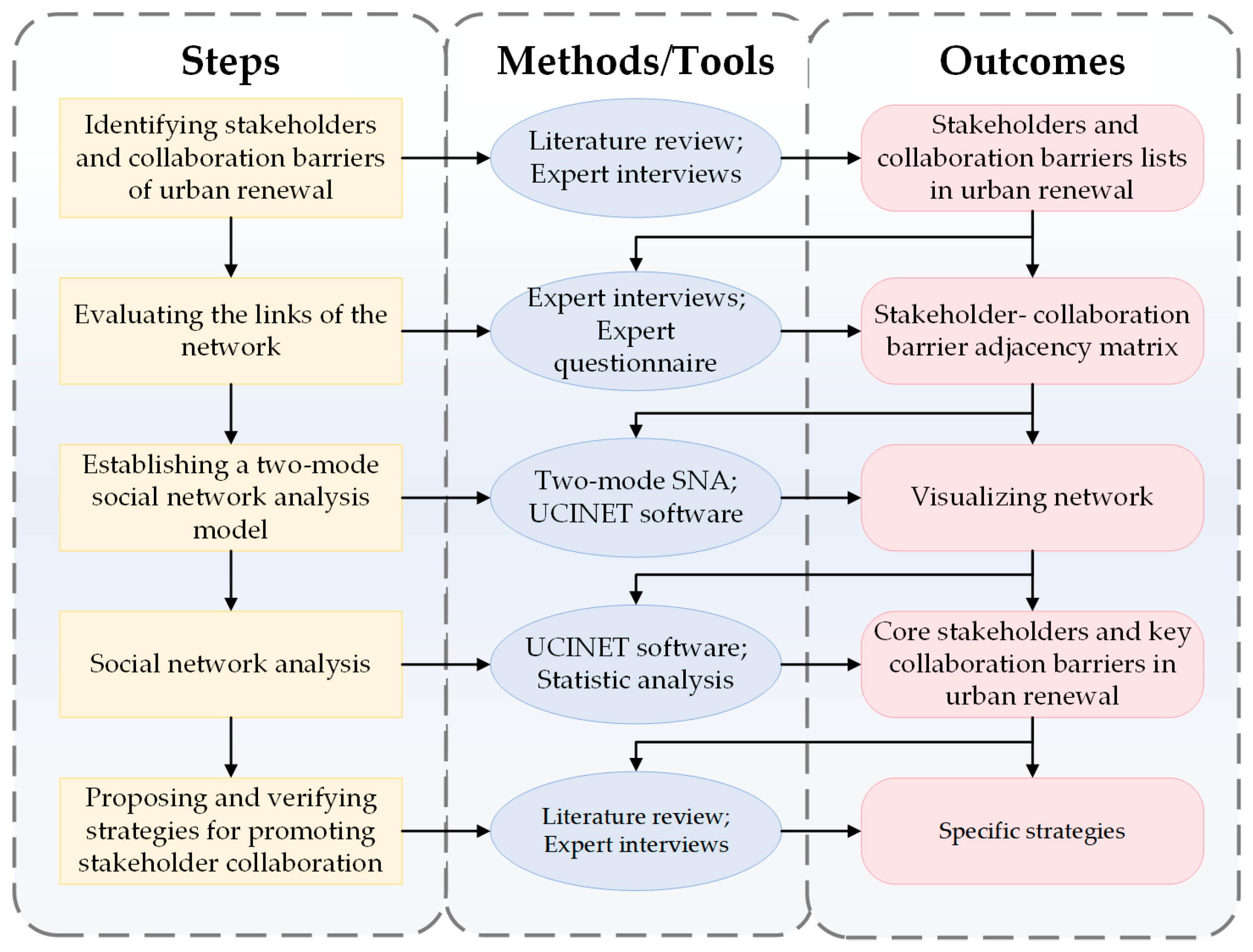
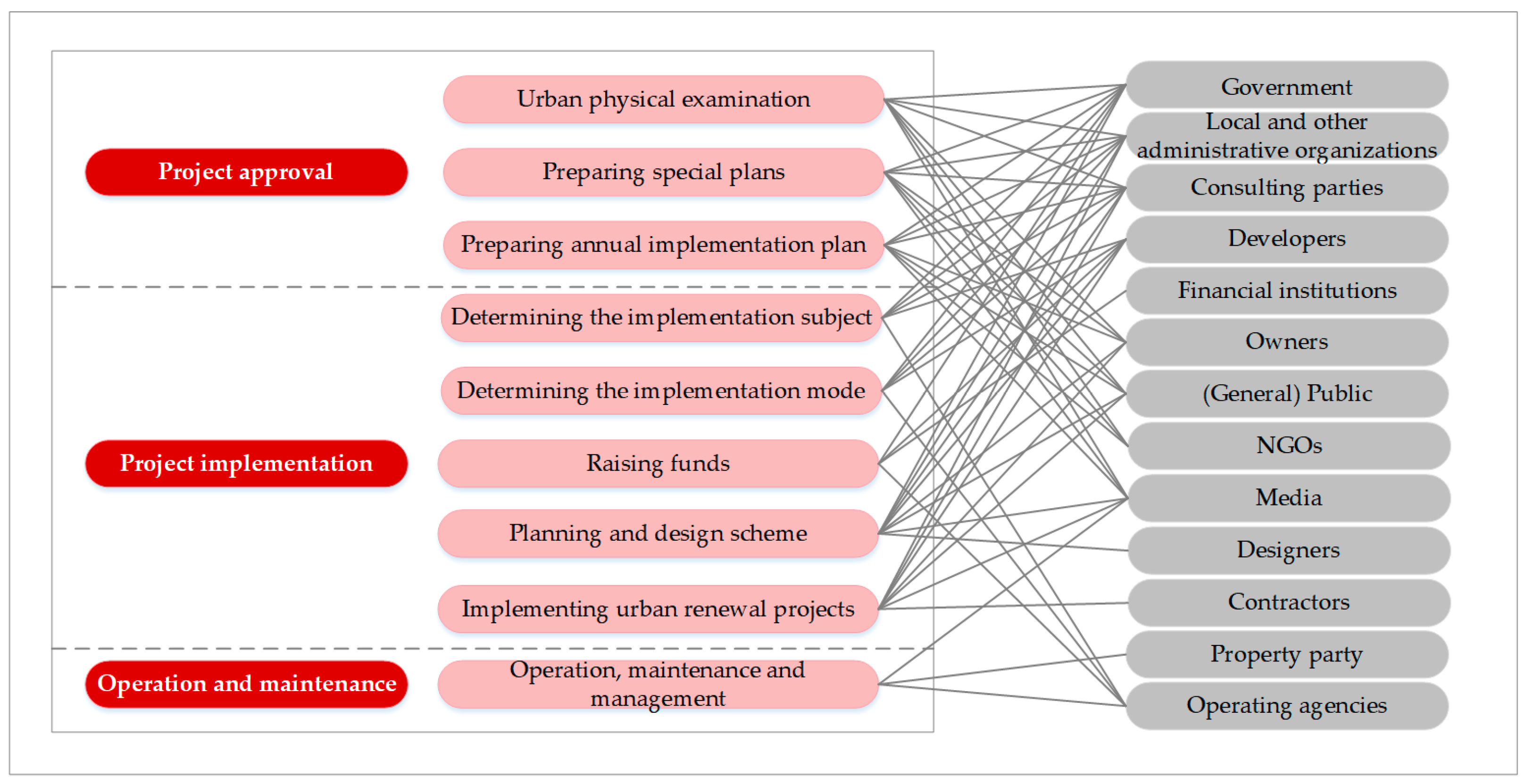
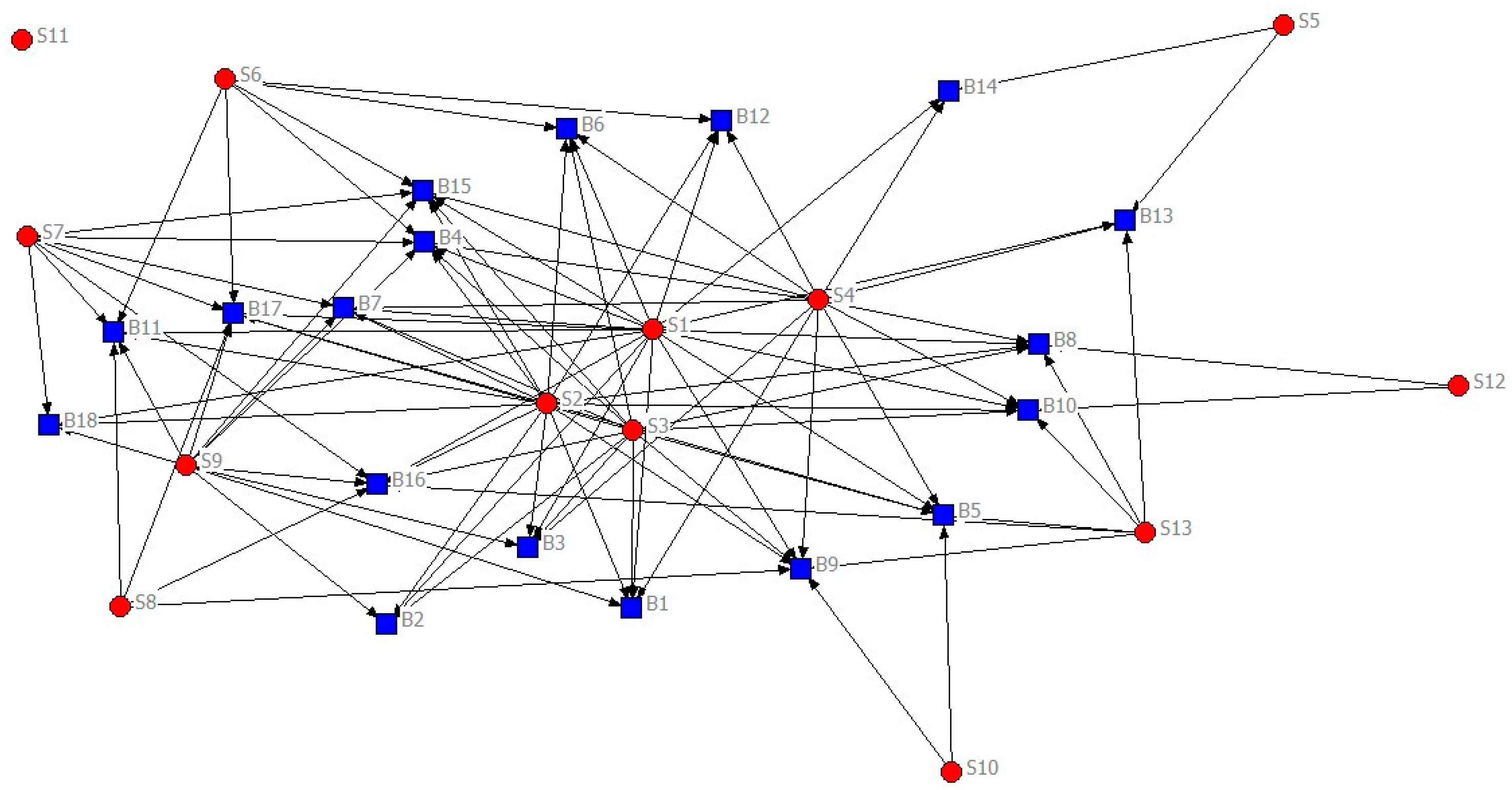

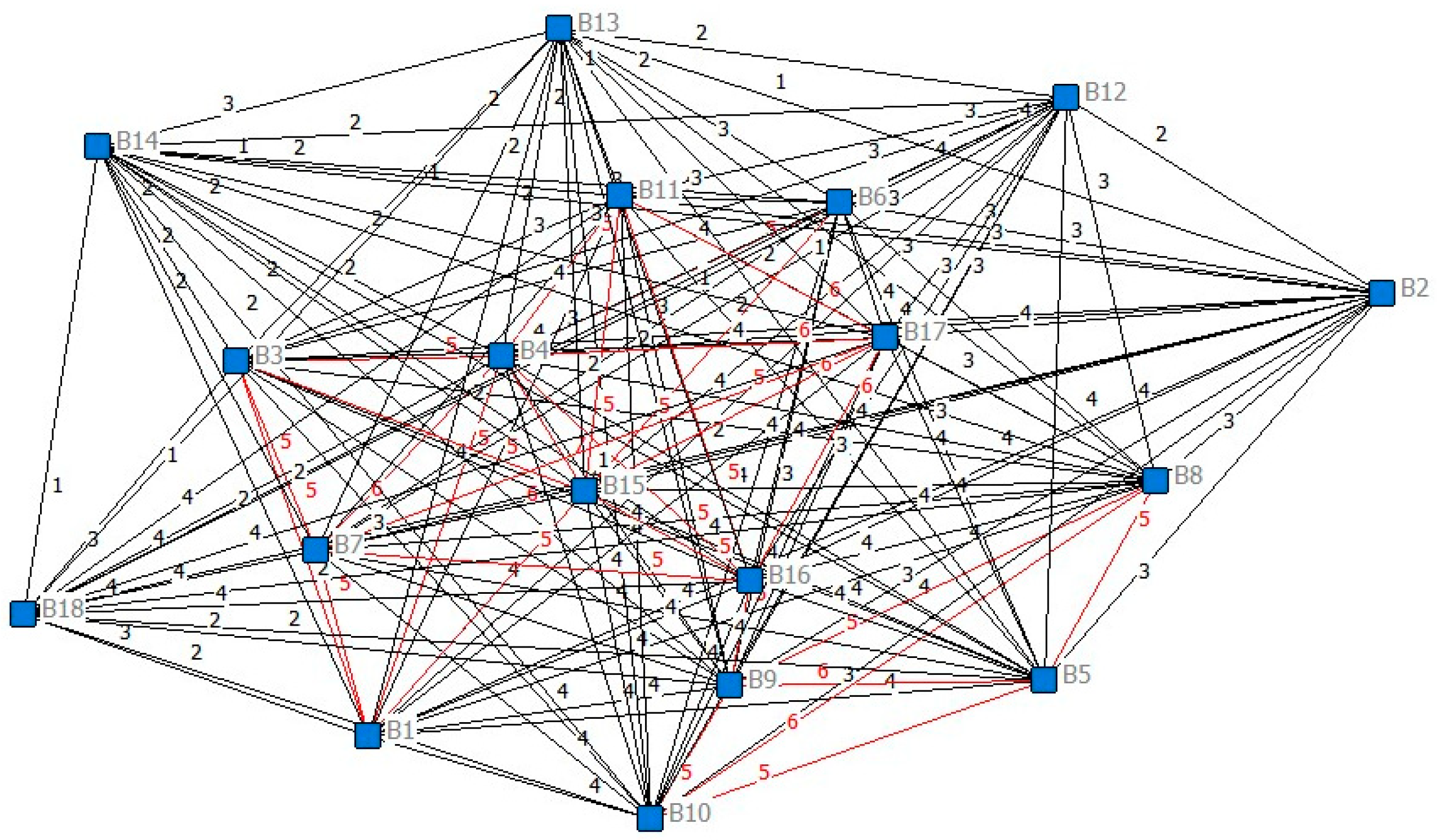

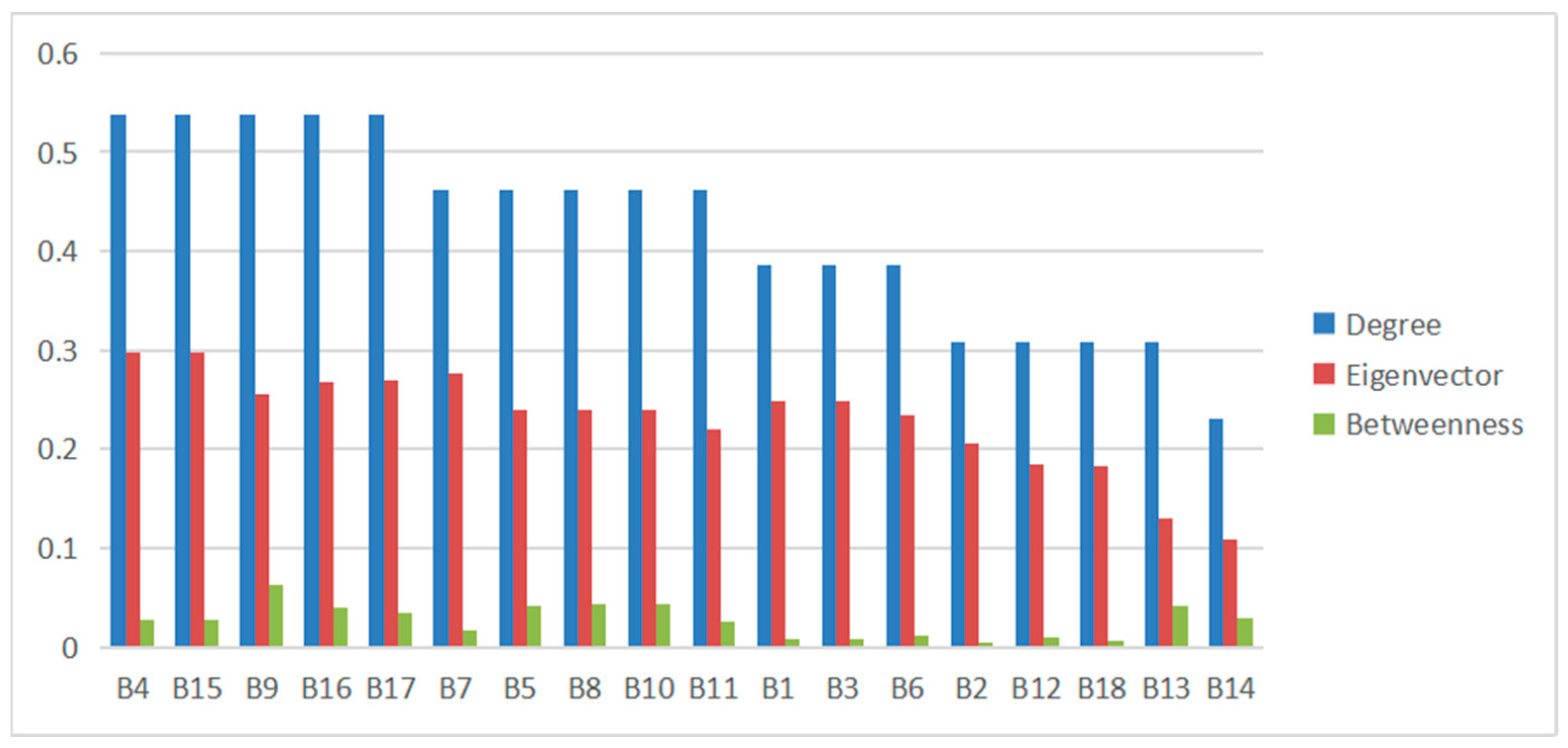
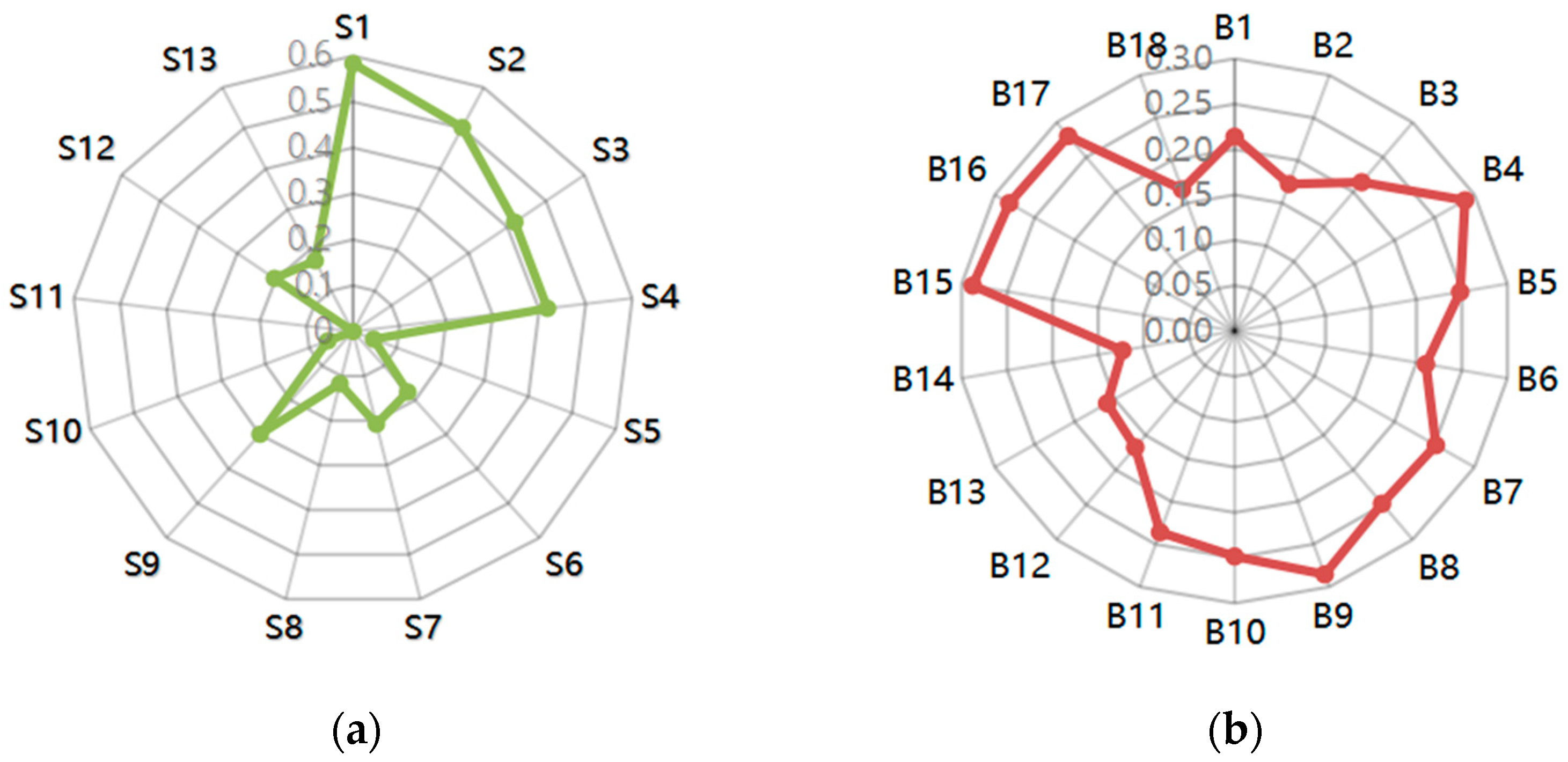
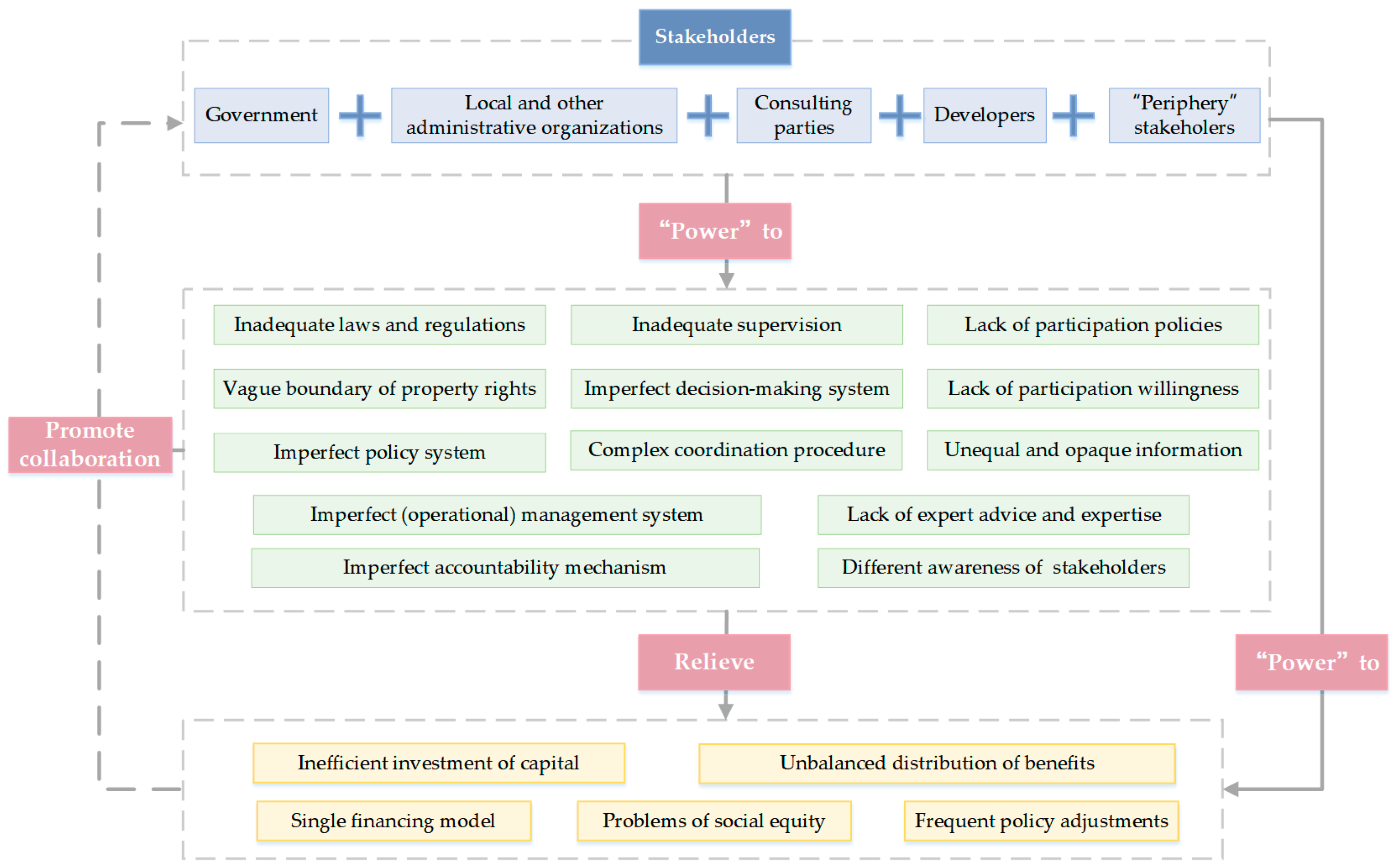
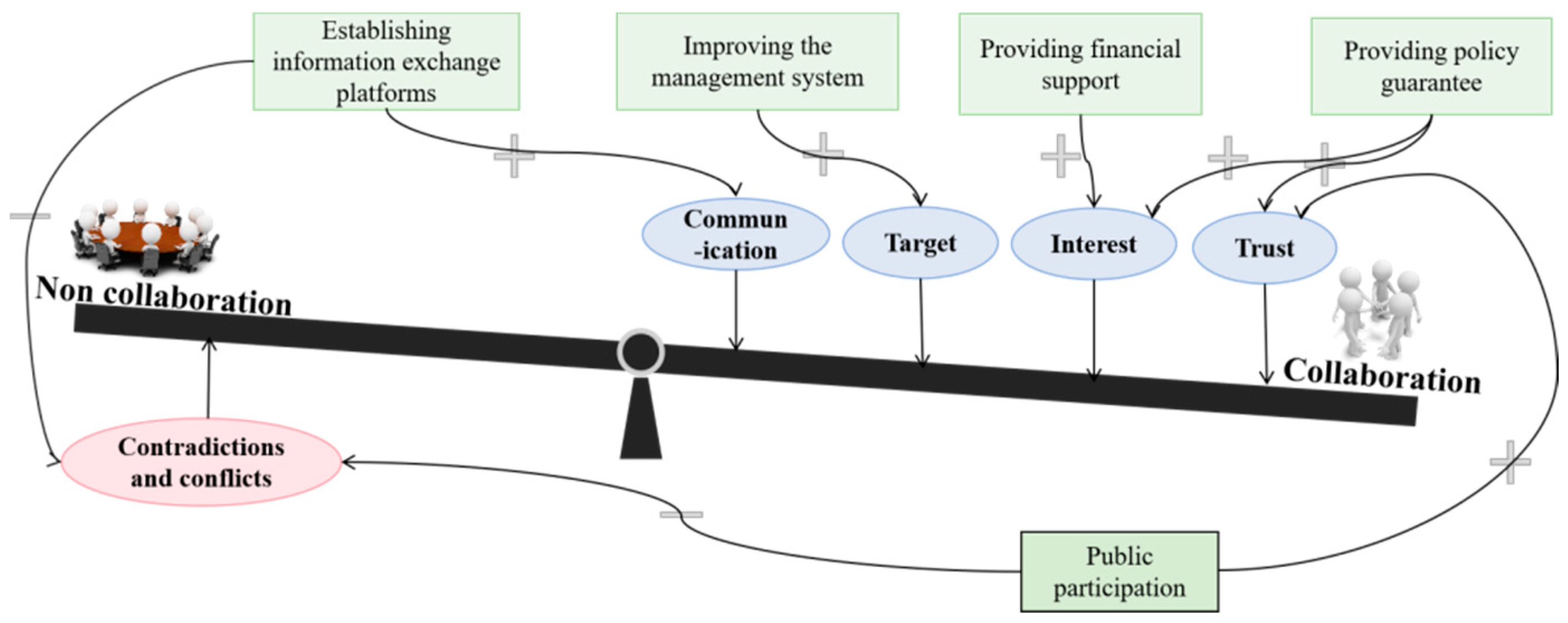

| Experts Number | Company Characteristics | Position | Years of Working |
|---|---|---|---|
| Experts 1 | Bank | Branch president | 25 |
| Experts 2 | Street office, community committee | Section chief of housing expropriation service center | 11 |
| Experts 3 | Real estate development company | General manager | 11 |
| Experts 4 | Expert scholar | Associate professor | 5 |
| Experts 5 | Real estate appraisal agency | Deputy general manager of real estate consulting company | 15 |
| Experts 6 | The media | Deputy editor-in-chief | 18 |
| Experts 7 | The government | Deputy director of Urban Planning Bureau | 30 |
| Experts 8 | Real estate appraisal agency | Real estate appraiser | 5 |
| Experts 9 | Design company | The engineer | 5 |
| Experts 10 | The contractor | Project manager of construction | 20 |
| The Unit Distribution | Education Level | ||
| Government | 8.47% | Junior college or below | 4.75% |
| Local and other administrative organization | 15.25% | Undergraduate | 61.36% |
| Consulting party | 17.29% | Master | 26.78% |
| Developer | 12.54% | Doctor and above | 7.12% |
| Financial institution | 12.20% | Work experience | |
| NGOs | 3.05% | Less than 1 year | 14.92% |
| Media | 5.08% | 1–5 years | 29.83% |
| Designers | 11.86% | 6–10 years | 17.29% |
| Contractor | 10.17% | 11–15 years | 20% |
| Property management company | 2.71% | 16–20 years | 5.76% |
| Operating agency | 1.36% | Over 20 years | 12.2% |
| No. of Negative Competencies | 3 |
|---|---|
| Largest eigenvalue | 141.754 |
| 2nd largest eigenvalue | 9.708 |
| Ratio of largest to next | 14.601 |
| B1 | B2 | B3 | B4 | B5 | B6 | B7 | B8 | B9 | B10 | B11 | B12 | B13 | B14 | B15 | B16 | B17 | B18 | SUM | |
|---|---|---|---|---|---|---|---|---|---|---|---|---|---|---|---|---|---|---|---|
| S1 | 1 | 1 | 1 | 1 | 1 | 1 | 1 | 1 | 1 | 1 | 1 | 1 | 1 | 1 | 1 | 1 | 1 | 1 | 18 |
| S2 | 1 | 1 | 1 | 1 | 1 | 1 | 1 | 1 | 1 | 1 | 1 | 1 | 0 | 0 | 1 | 1 | 1 | 1 | 16 |
| S3 | 1 | 1 | 1 | 1 | 1 | 1 | 1 | 1 | 1 | 1 | 0 | 0 | 0 | 0 | 1 | 1 | 1 | 0 | 13 |
| S4 | 1 | 0 | 1 | 1 | 1 | 1 | 1 | 1 | 1 | 1 | 0 | 1 | 1 | 1 | 1 | 0 | 0 | 0 | 13 |
| S5 | 0 | 0 | 0 | 0 | 0 | 0 | 0 | 0 | 0 | 0 | 0 | 0 | 1 | 1 | 0 | 0 | 0 | 0 | 2 |
| S6 | 0 | 0 | 0 | 1 | 0 | 1 | 0 | 0 | 0 | 0 | 1 | 1 | 0 | 0 | 1 | 0 | 1 | 0 | 6 |
| S7 | 0 | 0 | 0 | 1 | 0 | 0 | 1 | 0 | 0 | 0 | 1 | 0 | 0 | 0 | 1 | 1 | 1 | 1 | 7 |
| S8 | 0 | 0 | 0 | 0 | 0 | 0 | 0 | 0 | 1 | 0 | 1 | 0 | 0 | 0 | 0 | 1 | 1 | 0 | 4 |
| S9 | 1 | 1 | 1 | 1 | 0 | 0 | 1 | 0 | 0 | 0 | 1 | 0 | 0 | 0 | 1 | 1 | 1 | 1 | 10 |
| S10 | 0 | 0 | 0 | 0 | 1 | 0 | 0 | 0 | 1 | 0 | 0 | 0 | 0 | 0 | 0 | 0 | 0 | 0 | 2 |
| S11 | 0 | 0 | 0 | 0 | 0 | 0 | 0 | 0 | 0 | 0 | 0 | 0 | 0 | 0 | 0 | 0 | 0 | 0 | 0 |
| S12 | 0 | 0 | 0 | 0 | 0 | 0 | 0 | 1 | 0 | 1 | 0 | 0 | 0 | 0 | 0 | 0 | 0 | 0 | 2 |
| S13 | 0 | 0 | 0 | 0 | 1 | 0 | 0 | 1 | 1 | 1 | 0 | 0 | 1 | 0 | 0 | 1 | 0 | 0 | 6 |
| SUM | 5 | 4 | 5 | 7 | 6 | 5 | 6 | 6 | 7 | 6 | 6 | 4 | 4 | 3 | 7 | 7 | 7 | 4 |
| Barrier | |||
| Core | Periphery | ||
| Stakeholder | Core | 0.918 | 0.579 |
| Periphery | 0.273 | 0.140 | |
| Final fitness: 0.772 | |||
| B1 | B11 | B3 | B4 | B5 | B6 | B7 | B8 | B9 | B10 | B15 | B16 | B17 | B14 | B2 | B12 | B13 | B18 | |
|---|---|---|---|---|---|---|---|---|---|---|---|---|---|---|---|---|---|---|
| S1 | 1 | 1 | 1 | 1 | 1 | 1 | 1 | 1 | 1 | 1 | 1 | 1 | 1 | 1 | 1 | 1 | 1 | 1 |
| S2 | 1 | 1 | 1 | 1 | 1 | 1 | 1 | 1 | 1 | 1 | 1 | 1 | 1 | 1 | 1 | 1 | ||
| S3 | 1 | 1 | 1 | 1 | 1 | 1 | 1 | 1 | 1 | 1 | 1 | 1 | 1 | |||||
| S4 | 1 | 1 | 1 | 1 | 1 | 1 | 1 | 1 | 1 | 1 | 1 | 1 | 1 | |||||
| S5 | 1 | 1 | ||||||||||||||||
| S6 | 1 | 1 | 1 | 1 | 1 | 1 | ||||||||||||
| S7 | 1 | 1 | 1 | 1 | 1 | 1 | 1 | |||||||||||
| S8 | 1 | 1 | 1 | 1 | ||||||||||||||
| S9 | 1 | 1 | 1 | 1 | 1 | 1 | 1 | 1 | 1 | 1 | ||||||||
| S10 | 1 | 1 | ||||||||||||||||
| S11 | ||||||||||||||||||
| S12 | 1 | 1 | ||||||||||||||||
| S13 | 1 | 1 | 1 | 1 | 1 | 1 |
Publisher’s Note: MDPI stays neutral with regard to jurisdictional claims in published maps and institutional affiliations. |
© 2022 by the authors. Licensee MDPI, Basel, Switzerland. This article is an open access article distributed under the terms and conditions of the Creative Commons Attribution (CC BY) license (https://creativecommons.org/licenses/by/4.0/).
Share and Cite
Li, L.; Zhu, J.; Duan, M.; Li, P.; Guo, X. Overcoming the Collaboration Barriers among Stakeholders in Urban Renewal Based on a Two-Mode Social Network Analysis. Land 2022, 11, 1865. https://doi.org/10.3390/land11101865
Li L, Zhu J, Duan M, Li P, Guo X. Overcoming the Collaboration Barriers among Stakeholders in Urban Renewal Based on a Two-Mode Social Network Analysis. Land. 2022; 11(10):1865. https://doi.org/10.3390/land11101865
Chicago/Turabian StyleLi, Lingyan, Jiaxin Zhu, Mimi Duan, Pingbo Li, and Xiaotong Guo. 2022. "Overcoming the Collaboration Barriers among Stakeholders in Urban Renewal Based on a Two-Mode Social Network Analysis" Land 11, no. 10: 1865. https://doi.org/10.3390/land11101865
APA StyleLi, L., Zhu, J., Duan, M., Li, P., & Guo, X. (2022). Overcoming the Collaboration Barriers among Stakeholders in Urban Renewal Based on a Two-Mode Social Network Analysis. Land, 11(10), 1865. https://doi.org/10.3390/land11101865








